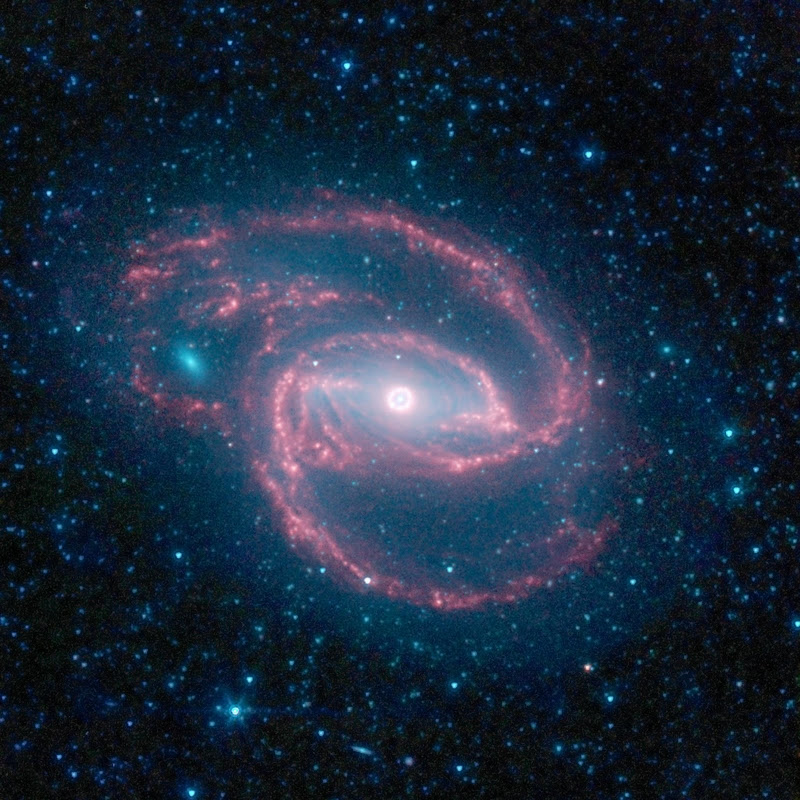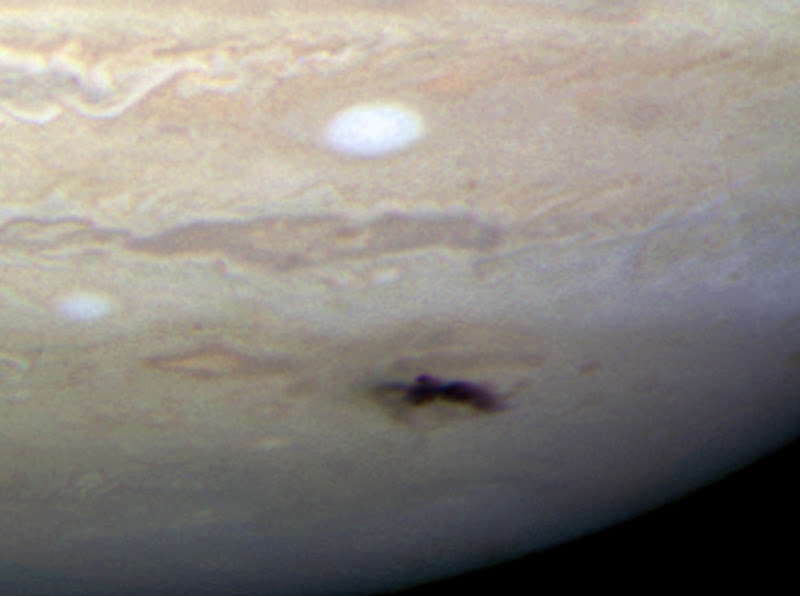Soap Bubble Nebula (PN G75.5+1.7)




The galaxy, called NGC 1097, is located 50 million light-years away. It is spiral-shaped like our Milky Way, with long, spindly arms of stars. The "eye" at the center of the galaxy is actually a monstrous black hole surrounded by a ring of stars. In this color-coded infrared view from Spitzer, the area around the invisible black hole is blue and the ring of stars, white.
The black hole is huge, about 100 million times the mass of our sun, and is feeding off gas and dust along with the occasional unlucky star. Our Milky Way's central black hole is tame by comparison, with a mass of a few million suns.
The galaxy's red spiral arms and the swirling spokes seen between the arms show dust heated by newborn stars. Older populations of stars scattered through the galaxy are blue. The fuzzy blue dot to the left, which appears to fit snuggly between the arms, is a companion galaxy.
 |
| Earth Observatory - Eclipse Shadows Southeastern China July 23, 2009: "The Moon's shadow engulfed Taiwan and a large swath of southeastern China and the Pacific Ocean on the morning of July 22, 2009, during an unusually long total eclipse of the Sun. ..." |
 |
| This image was produced from data from EUMETSAT's Meteosat-7 satellite which is located over the Indian Ocean, received over EUMETCast by my MSG Data Manager, with the false-colour combination produced by my GeoSatSignal-7 software combining both visible-channel and thermal-channel data from the satellite. Credit: GeoSatSignal |
 |
| Earth Observatory - Total Solar Eclipse of March 29, 2006: "The International Space Station (ISS) was in position to view the umbral (ground) shadow cast by the Moon as it moved between the Sun and the Earth during the solar eclipse on March 29, 2006. This astronaut image captures the umbral shadow across southern Turkey, northern Cyprus, and the Mediterranean Sea..." |
 |
| The lunar umbra on the Indian Ocean taken from the International Space Station. |
 |
| NASA/GSFC/Aqua/Jacques Descloitres, MODIS Rapid Response Team: Total solar eclipse over Antarctica... |
 |
| ISS012-E-21343 (29 Mar. 2006) --- The shadow of the moon falls on Earth as seen from the International Space Station, 230 miles above the planet, during a total solar eclipse at about 4:50 a.m. CST Wednesday, March 29. This digital photo was taken by the Expedition 12 crew, Commander Bill McArthur and Flight Engineer Valery Tokarev, who are wrapping up a six-month mission on the complex. Visible near the shadow are portions of Cyprus in the Mediterranean Sea and the coast of Turkey. |
 |
| APOD - August 30, 1999: "Here is what the Earth looks like during a solar eclipse. The shadow of the Moon can be seen darkening part of Earth. This shadow moves across the Earth at nearly 2000 kilometers per hour. Only observers near the center of the dark circle see a total solar eclipse - others see a partial eclipse where only part of the Sun appears blocked by the Moon. This spectacular picture of the 1999 August 11 solar eclipse was one of the last ever taken from the Mir space station, as Mir is being decommissioned after more than ten years of productive use." |
 |
| Map of total solar eclipse paths 2001-2025. Credit: Michæl Paukner |
 This image shows a large impact on Jupiter's south polar region captured on July 20, 2009, by NASA's Infrared Telescope Facility in Mauna Kea, Hawaii. Image Credit: NASA/JPL/Infrared Telescope Facility
This image shows a large impact on Jupiter's south polar region captured on July 20, 2009, by NASA's Infrared Telescope Facility in Mauna Kea, Hawaii. Image Credit: NASA/JPL/Infrared Telescope Facility
 This infrared image taken with Keck II shows the new feature observed on Jupiter and its relative size compared to Earth. Image Credit: Paul Kalas (UCB), Michael Fitzgerald (LLNL/UCB), Franck Marchis (SETI Institute/UCB), James Graham (UCB)
This infrared image taken with Keck II shows the new feature observed on Jupiter and its relative size compared to Earth. Image Credit: Paul Kalas (UCB), Michael Fitzgerald (LLNL/UCB), Franck Marchis (SETI Institute/UCB), James Graham (UCB)
 Image credit: NASA, ESA, and H. Hammel (Space Science Institute, Boulder, Colo.), and the Jupiter Comet Impact Team.
Image credit: NASA, ESA, and H. Hammel (Space Science Institute, Boulder, Colo.), and the Jupiter Comet Impact Team.
 gigapan: Ant-Eutetramorium mocquerysi
gigapan: Ant-Eutetramorium mocquerysi